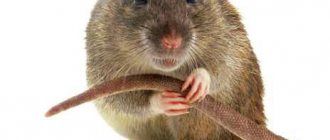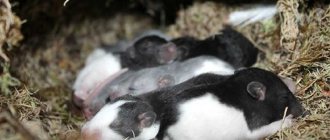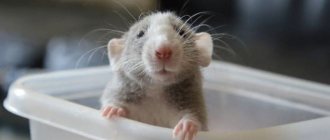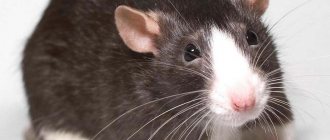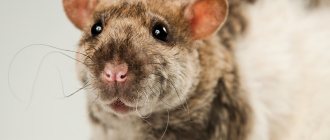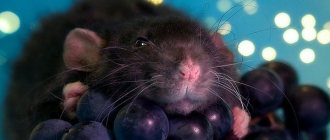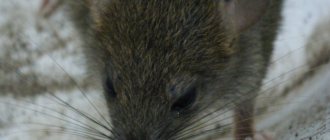Every inhabitant of our planet knows about rats. Rodents are found in rural areas and urban buildings. They annoy people in private houses and apartments in multi-storey buildings. Wild rats periodically settle in human possessions and do not behave in the best way - they damage furniture and destroy food supplies. In addition, rats spread diseases. On the territory of our country there are 3 species of wild rats - gray, or Pasyuk, black, Turkestan. The Edwards decorative rat is imported for keeping at home. Photos of wild rats can be seen below.
[edit] Systematics and distribution of species
→ Types of rats
Black rat
According to one source, there are 56 species of rats.[1] However, according to other sources there may be much more.
Numerous species of rats are distributed throughout the globe. Many other genera of medium-sized rodents are also called rats, adding some adjective to this word, for example, kangaroos, large-toothed, rocky, earless, large-eared, and the like.
However, in the ordinary understanding, the word “rat” primarily refers to the gray rat, or pasyuk. This familiar beast is found in most cities in the temperate zone, especially in Europe, the northern United States and Canada. The black rat lives alongside humans throughout the Mediterranean, the southern United States, and Central and South America.
Initially, the distribution of gray and black rats was limited to the Old World, but they have now spread to all continents and most of the islands of the globe.
There are two species in Russia[2]:
- Gray rat - Rattus norvegicus
- Black Rat - Rattus rattus
Lifestyle Features
Pasyuki are fans of shadow hunting. Their activity occurs in the evening and night hours (19.00-8.00), but the peak is 20.00-22.00. True, if the need arises, they can be active during the daytime.
They live in families (colonies) and are very aggressive when strangers appear on their territory. Members of their herd are recognized by smell. The natural homes of rats are holes, other people's nests, previously destroyed, hollows, stumps, and snags. “City” residents - pasyuki live in basements, garages, garbage heaps, sewer mines, etc.
The diet consists of food waste from garbage dumps, fish, meat, agricultural crops, etc. Rats have exceptional survival, adaptive qualities, a sharp mind, caution and resourcefulness. In addition, the gray scammer swims well, dives, jumps almost a meter in height and is capable of reaching speeds of up to 12 km/h.
[edit] Appearance
Gray rat Rats
are distinguished from other rodents by their long, bare tail, covered with ring-shaped scales. It is round in cross-section, its length is equal to or greater than the length of the body [3], and gradually becomes thinner towards the end. The tail may be covered with sparse, short hair.
The rats are small to medium in size. Body length is 8-30 cm. The weight of the animal varies in some species from 37-39 grams, to 400-420 grams in the largest species.
Gray-brown or dark gray tones are key to the coloring of these rodents, although yellow, red, orange tones, as well as white, are considered natural. The dorsal side of the body is black, grayish, brown, yellowish or red. The belly is usually gray or whitish. The fur is relatively coarse, the guard hairs in most species are well developed, but the spines of the back of the back do not stand out sharply in their length. The hair can be lengthened or turned into bristles or even needles.
The appearance of different species varies significantly. The physique can be heavy or light.
The muzzle is elongated, the eyes are large. Medium-sized, rounded ears, hairless or with thin, sparse hairs.
The feet are elongated, the toes are relatively long. The mobility of the rat's toes compensates for the underdevelopment of calluses, which are necessary for climbing.
The number of nipples is from 8 to 12. The central appendage os penis completely ossifies.
A rat skull with a relatively long facial region and a large brain capsule. The ilium is relatively short with a distinctly distinct, rounded iliac tubercle. The femur is relatively long, with a relatively long and low third and blunted lesser trochanter. The accreted part of the fibula is shortened, as is the humerus. The olecranon process is relatively long.
[edit] Behavior and lifestyle
The lifestyle of rats is divided into 4 types. Most species are active at night.
- Wood forms.
Rats belonging to this type have an elongated, thin body. The tail is longer than the body and in some species is prehensile. The plantar tubercles are large and convex. The claws are small, strongly curved, and sharp. - Ground forms.
They have a denser build than woody ones. The tail is not prehensile. Its length is shorter than the length of the body or equal to it. The plantar tubercles are small and flat. A significant number of species belong to this ecological type. - Burrowing forms.
Most species of true rats are associated with burrowing and digging to some degree. The species from Christmas Island (R. nativitatis) is specialized in this direction. These large rats have a ridged body, large hands and feet, armed with wide and long claws, especially on the front legs. The tail is short and thick. - Near-aquatic forms.
Closely related to water. However, their morphological specialization in this direction did not go far. In the gray rat, the skin between the toes of the hind paws forms a small membrane.
Rats are solitary or live in family groups or territorial groups of up to 200 individuals with a pronounced hierarchy. Dominant males are territorial and quite aggressive. The most vulnerable part of their body is the tail; it often shows scars from wounds inflicted by its relatives.
Burrows and natural voids in the ground and trees serve as shelters for rats. Moreover, the rats' homes are rather sloppy. One rat family owns an area with a radius of about 150 m.
[edit] Food
Most rats are distinguished by their omnivorous nature, but different species also have their own preferences.
Some species prefer plant foods, which include fruits, vegetables and plant seeds. Others prefer animal food - various mollusks, insects and other small invertebrates.
Gray rats may demonstrate different menu preferences. They vary from population to population.
[edit] Reproduction
Rats
breed almost all year round and their numbers can grow very quickly.
Pregnancy usually lasts 21 days, the number of cubs in the litter is from 3 to 12, with an average of 8. A pregnant female needs material for a nest. These can be a variety of combs, pieces of cotton wool, fluff, paper. Rats are born naked and blind, but develop quickly. Their eyes open around the 15th day, and after 3 weeks they look for food on their own.
At the age of two years, the rat stops reproducing, and by the age of three it becomes decrepit and loses its teeth.
[edit] Life expectancy
Rats live up to 1.5 years in nature and up to 3-4 years in captivity.
[edit] Intelligence
Rats are unusually smart and quick-witted animals.
To get to food, they literally perform circus tricks. So, miners, trying to protect their breakfast from rats, hung packages of food from the ceiling. Pasyuki climbed up the wall and, pushing off, jumped onto the bag, chewed through the rope and fell to the floor along with their prey.
Rats can drink kefir from a bottle. To do this, they lower the tail into the bottle, then take it out and, holding it with their front paws, quickly lick the kefir off it, after which they lower the tail into the bottle again.
It is very interesting for rats to drag chicken eggs: one of the rats lies on its back, the second rolls the egg onto its chest and then drags it by the tail, and the rat, thus drawn, holds the egg tightly with its paws so as not to drop it and break it.
[edit]Enemies
Ratcatcher cat with a rat in its teeth
Rats are hunted by birds of prey, for example, eagle owls and animals such as martens, foxes and others. However, since rats live near human habitation, they are usually not threatened by attacks from these predators.
As for domestic cats, only a few of them decide to attack such a large rodent.
"Rat King"
Zoologists have not yet been able to fully explain the phenomenon of the so-called “rat king”. This phenomenon is quite widespread among these animals. What it is? This is a huge ball consisting of rodents, legs and tails tightly intertwined with each other. Every rat is involved in the Rat King. A large pile of these creatures can include up to 60-70 individuals.
All representatives of the “rat king” live off the offerings of other relatives. Why? Because they themselves, even with all their desire, will not be able to move from their place: their paws and tails are literally chained. Scientists are trying to find an answer to this mystery of nature, but so far they have not succeeded. It’s not for nothing that they say that one of the smartest animals on earth is the rat (gray, black, white, decorative). Let's take a closer look at decorative ones.
[edit]Confinement in captivity
→ Decorative rats
Decorative hairless rat
Tame rats have been kept as pets since at least the 19th century. These are usually specially bred varieties of gray rats, but there are also tame varieties of black rats.
Tame rats behave differently than their wild ancestors, depending on how long they have been bred as pets.
White rats are also bred in laboratories and kept as pets.
They were excommunicated...
Once upon a time, these creatures kept towns and cities at bay. In the XIII-XV centuries, they were generally the root cause of death of the population from certain infectious diseases, such as cholera. The famous naturalist Roussenel once compared the invasion of rats with the raids of the hordes of Attila and Genghis Khan.
As soon as humanity did not fight rats. These creatures were destroyed in hundreds and thousands. In the fight against them, people used the most effective poisons, boiling water, fire. It is curious that rats were even excommunicated from the church, calling down a curse from heaven on their entire race! There are about 64 different species of these rodents, but only three are mainly known: the gray, black and white (ornamental) rat.
[edit] Danger to humans
Population of rats near human habitation
Rats can spread typhus, bubonic plague, jaundice, tularemia, rabies and trichinosis.
They are especially numerous in landfills and sewer systems, and they transmit infections by contaminating stored food products.
Rats cause harm in various sectors of human economic activity, damaging and contaminating food and various industrial products, as well as wooden parts of building structures and vehicles.
Damage caused by wild rodents
The range of animals is wide. Rodents are able to survive in the most difficult situations. They eat a lot of grains and foodstuffs. Structures and special equipment are being destroyed. They destroy small animals and birds. It affects forest plantings, trees in gardens, plants in vegetable gardens and fields.
Despite the varied types of damage caused by rats, this is not particularly taken into account. Some sources provide approximate information about the number of these individuals in each country and the damage they cause.
The pasyuk (gray) rat absorbs 20 kg of grain per year. There are 2 rats for every inhabitant of the planet.
In some countries and localities, the number of rats is simply terrifying. In India, the ratio of people to rats reaches 1:10. It is impossible to imagine that in the city of Bombay alone there are approximately 20 million of them.
Many people go to hospitals with rat bites. The favorite habitat of these animals is cattle farms. There they cause great harm to animals and feed.
[edit] Facts
Igor Maikov “Two rats steal an egg”
- Research over the past decade has led to the surprising discovery that rats (particularly young rats) can laugh! This conclusion was made by scientist Jaak Panksepp, who published an article in the journal Behavioral Brain Research describing his position on this issue.[4][5]
- The animal that can go the longest without drinking is not the camel, as is commonly believed. This is a rat.
- Rats find their way out of a maze faster if Mozart's music is playing at the same time.[6]
- The well-known laboratory white rat is an albino form of the red rat.
- The Chinese treat the rat most warmly: for them it symbolizes prosperity and is considered one of the symbols of “Yang” - the feminine principle.
- Oxford scientists concluded from their research that abstract thinking is inherent in rats, which deprives humans of their status as the only life form with such a skill.[7]
- Rats can not only perfectly adapt to a wide variety of poisons, but are also able to recognize certain types of toxic substances that humans use against them. If at least one individual survives poisoning from the entire generation and produces offspring, then the immunity and tolerance of this offspring to this poison will remain for a long time.[8]
- By the beginning of the 16th century, professional rat catchers appeared[9].
What to do if there are rats
Rats in the house or on the property are pests. They spoil human supplies and harm plantings, bulbs and young trees. They scare livestock and even easily steal eggs.
It is also worth noting that rats are carriers of many diseases in humans and animals. You can read more details at the link.
There are a number of steps that will help avoid the appearance of rats and drive them out of the area:
- Keep storage areas for vegetables and cereals and livestock areas clean.
- Remove accumulations of debris from areas, thickets and reins.
- Get pets that repel rats with their smell: cats and dogs.
- Check for the presence of rats, mice and moles.
- If the area is in a risk zone, install repellers in advance.
Using the links to articles on the portal, you can get acquainted with all the possibilities for exterminating rats on the site and for prevention.
How to get rid of rats in a barn
Rats in the barn scare the animals and steal eggs. You need to get rid of them quickly, but at the same time take care of the safety of other residents.
How to get rid of rats on your property
Rats on the site spoil crops, bulbs, roots and gnaw the bark or shoots of young trees. They must be removed quickly, without delay.
[edit] Sources
- ITIS taxonomy
- Encyclopedia of Russian nature. — M.: ABF. V. L. Dinets, E. V. Rothschild. 1998.
- Gromov I.M., Erbaeva M.A. Mammals of the fauna of Russia and adjacent territories. Lagomorphs and rodents. - St. Petersburg, 1995. - P. 259-261. — 522 p. — 1000 copies.
- Do animals have a sense of humor? Rats for sure.
- Rats have a sense of humor.
- Morozov V.P. Entertaining bioacoustics. Ed. 2nd, additional, revised - M.: Znanie, 1987. - 208 pp. + 32 pp. incl.— pp. 54—59
- The rats figured out the rules
- The rat's adaptation mechanism to poisons is human envy
- Toothy gang. Why rats are taking over Russia and how to fight it (Alena Shapovalova, life.ru)
Reproductive functions
Rats do not have any special mating period. They are always ready to reproduce, but the peak of reproductive activity occurs in spring and summer.
Gray rodents are more fertile than their other species. Each pubescent female can mate with several males. The gestation period for the cubs lasts 24 days. If the female has brought babies and is still feeding them, a new pregnancy occurs within 34 days.
They give birth in a nest that consists of blades of grass, paper and textile waste. A female rodent can give birth to one to twenty babies. They are born without hair, with closed eyelids.
The female eats weak, incapable cubs. Rats are good mothers. They clean up the nest, lick the babies, and feed them high-calorie milk.
But male dads are useless. Male rodents that are indifferent to their offspring can eat the young.
After 17 days, the pups' eyes open. After a month, they can exist separately from their mother.
[edit] Literature
- Great Soviet Encyclopedia. - M.: Soviet Encyclopedia. 1969-1978.
- Big Encyclopedic Dictionary. 2000.
- Collier's Encyclopedia. — Open society. 2000.
- Big medical encyclopedia. 1970.
- Encyclopedic Dictionary. 2009.
- Ushakov's explanatory dictionary. D. N. Ushakov. 1935-1940.
- Encyclopedia of Brockhaus and Efron. - St. Petersburg: Brockhaus-Efron. 1890-1907.
- Biology. Modern illustrated encyclopedia. Ch. ed. A. P. Gorkin; M.: Rosman, 2006.
- Argiropulo A.I., Family Muridae - mice, M.-L., 1940 (Fauna of the USSR. Mammals, vol. 3, v. 5)
- Ellerman JR, The families and genera of living rodents, v. 3, pt I, L., 1949.
- Encyclopedia of Russian nature. — M.: ABF. V. L. Dinets, E. V. Rothschild. 1998.
